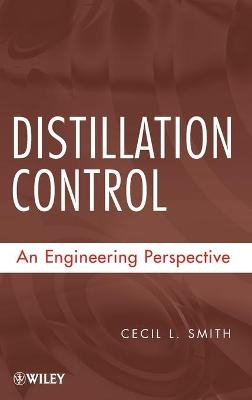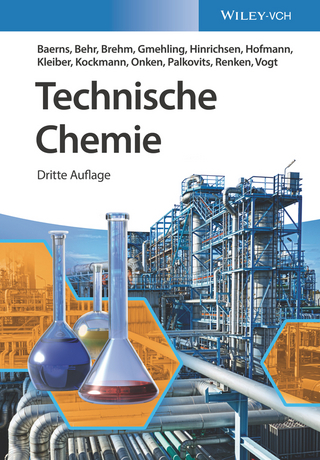
Distillation Control
John Wiley & Sons Inc (Verlag)
978-0-470-38194-6 (ISBN)
Today, distillation is by far the most common separation technique used in the chemical and petroleum industries. All distillation columns need to be carefully controlled in order to meet specified production and quality levels. Distillation Control enables readers to do this by approaching the subject from a process to develop, analyze, and troubleshoot all aspects of column controls. Readers are efficiency and effectiveness and minimizing coats.
Distillation Control begins with a chapter dedicated to underlying principles, including separation processes, reflux and boilup ratios, and composition dynamics. Next, the author covers such critical topics as:
Composition control
Pressure control and condensers
Reboilers and feed preheaters
Application of feedforward
Unit optimization
Complex towers
As readers progress through the text, they’ll discover that the best control configuration for a distillation column is largely determined using steady-state process characteristics. The stage-by-stage separation models that the author sets forth for column design, therefore, provide information that is essential in developing the optimal control configuration.
In addition to its clear explanations, Distillation Control is filled with clear diagrams and illustrations that clarify complex concepts and guide readers through multi-step procedures.
Engineers as well as other professionals working in process facilities that use distillation to separate materials will fin that this book enables them to implement the latest tested and proven distillation control methods to meet their particular processing needs.
Cecil L. Smith, PhD, is President of Cecil L. Smith, Inc. a firm specializing in automation technology, founded after he left the facility of Louisiana State University. Dr. Smith has more than thirty-five years of experience in process control, with expertise spanning almost all control technology currently in use in industrial production facilities. Dr. Smith has been listed among InTech magazine’s fifty most influential industry innovators.
Preface ix
1 Principles 1
1.1. Separation Processes 2
1.2. Total Material Balance 9
1.3. Reflux and Boilup Ratios 13
1.4. Total Material Balance around Condenser 18
1.5. Total Material Balance around Reboiler 21
1.6. Component Material Balances 24
1.7. Energy and the Separation Factor 28
1.8. Multicomponent Distillation 35
1.9. Stage-by-Stage Separation Model 38
1.10. Formulation of the Control Problem 47
1.11. Tower Internals 50
1.12. Flooding 55
1.13. Tray Hydraulics 59
1.14. Inverse Response in Bottoms Level 62
1.15. Composition Dynamics 65
References 69
2 Composition Control 70
2.1. Product Specifications 71
2.2. Columns in Series 75
2.3. Composition Analyzers 78
2.4. Temperature 83
2.5. Distillate Composition Control: Constant Boilup 91
2.6. Distillate Composition Control: Constant Bottoms Flow 96
2.7. Operating Lines 100
2.8. Temperature Profiles 106
2.9. Feed Composition Disturbances 111
2.10. Bottoms Composition Control 116
2.11. Propagation of Variance in Level Control Configurations 122
2.12. Level Control in Direct Material Balance Configurations 126
3 Pressure Control and Condensers 136
3.1. Pressure Control 137
3.2. Once-Through Heat Transfer Processes 142
3.3. Water-Cooled Condensers 147
3.4. Flooded Condensers 151
3.5. Air-Cooled Condensers 159
3.6. Partial Condensers 162
3.7. Atmospheric Towers 167
3.8. Vacuum Towers 169
3.9. Floating Pressure/Pressure Minimization 173
Reference 179
4 Reboilers and Feed Preheaters 180
4.1. Types of Reboilers 181
4.2. Steam-Heated Reboilers 185
4.3. Hot Oil 195
4.4. Fired Heaters 198
4.5. Feed Preheater 200
4.6. Economizer 204
References 208
5 Applying Feedforward 209
5.1. Feed Flow and Composition 210
5.2. Internal Reflux Control 220
5.3. Extreme Feedforward 226
5.4. Feedforward for Bottoms Level 229
5.5. Feedforward for Column Pressure 234
5.6. Product Compositions 238
Reference 242
6 Unit Optimization 243
6.1. Energy and Separation 244
6.2. Optimization of a Column 250
6.3. Constraints in Distillation Columns 255
6.4. Control Configurations for Single Constraint 258
6.5. Control Configurations for Multiple Constraints 266
References 272
7 Double-End Composition Control 273
7.1. Defining the Problem 273
7.2. Options for Composition Control 275
7.3. Relative Gain 283
7.4. Relative Gains from Open Loop Sensitivities 290
7.5. Relative Gains for Other Configurations 294
7.6. Ratios for Manipulated Variables 296
7.7. Effect of Operating Objectives 300
7.8. MPC 303
8 Complex Towers 306
8.1. Heat Integration 307
8.2. Side Heater/Side Cooler 311
8.3. Sidestreams 316
8.4. Withdrawing a Liquid Sidestream 319
8.5. Withdrawing a Vapor Sidestream 322
8.6. Composition Control in Sidestream Towers 324
Index 329
| Erscheint lt. Verlag | 8.6.2012 |
|---|---|
| Verlagsort | New York |
| Sprache | englisch |
| Maße | 165 x 241 mm |
| Gewicht | 612 g |
| Themenwelt | Naturwissenschaften ► Chemie ► Technische Chemie |
| Technik ► Elektrotechnik / Energietechnik | |
| Technik ► Maschinenbau | |
| ISBN-10 | 0-470-38194-9 / 0470381949 |
| ISBN-13 | 978-0-470-38194-6 / 9780470381946 |
| Zustand | Neuware |
| Haben Sie eine Frage zum Produkt? |
aus dem Bereich


